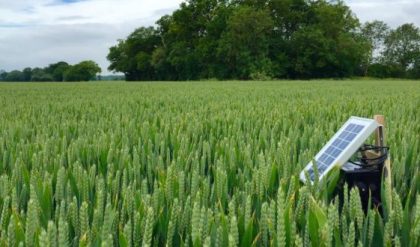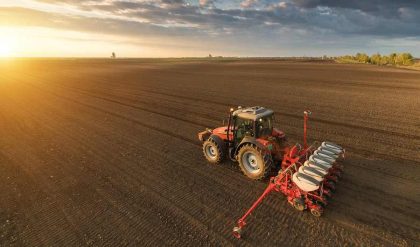Soil erosion is a gradual process that occurs when the impact of water or wind detaches and removes soil particles, causing the soil to deteriorate. Soil deterioration and low water quality due to erosion and surface runoff have become severe problems worldwide. The problem may become so severe that the land can no longer be cultivated and must be abandoned. Many agricultural civilizations have declined due to land and natural resource mismanagement, and the history of such civilizations is a good reminder to protect our natural resources. Erosion is a serious problem for productive agricultural land and for water quality concerns. Controlling the sediment must be an integral part of any soil management system to improve water and soil quality. Eroded topsoil can be transported by wind or water into streams and other waterways. Sediment is a product of land erosion and derives largely from sheet and rill erosion from upland areas, and to a lesser degree, from cyclic erosion activity in gullies and drainageways. The impact of soil erosion on water quality becomes significant, particularly as soil surface runoff. Sediment production and soil erosion are closely related. Therefore, the most effective way to minimize sediment production is the stabilization of the sediment source by controlling erosion. Several conservation practices can be used to control erosion but first you need to understand the factors affecting soil erosion. Soil erosion is the detachment and movement of soil particles from the point of origination through the action of water or wind. Thus, minimizing the impact of water or wind forces is the main objective for erosion control. Water erosion is the most pertinent erosion problem in Iowa.
Soil erosion by water occurs when bare-sloped soil surface is exposed to rainfall, and the rainfall intensity exceeds the rate of soil intake, or infiltration rate, leading to soil-surface runoff. Soil erosion can occur in two stages:
1) detachment of soil particles by raindrop impact, splash, or flowing water; and
2) transport of detached particles by splash or flowing water. Therefore, soil erosion is a physical process requiring energy, and its control requires certain measures to dissipate this energy.
The hydrologic processes of rainfall and runoff play an essential role in water erosion. The amount and rate of surface runoff can affect erosion and sediment transport. Thus, soil conservation practices are important in reducing soil erosion. Improving the soil infiltration rate, resulting in less surface runoff, can lead to reduction of soil erosion. Agronomic, cultural, or structural practices are available for controlling soil erosion. Structural practices involve physical changes in the shape and topography of the land. All these practices are not mutually exclusive. Some situations may require both management and structural changes, where the topography is highly complex. In other situations, erosion control can be achieved by implementing a single practice, where the erosion is minimum, such as the establishment of grassed waterways.
| Types of Erosion· Sheet erosion (water) is almost invisible. Lighter colored soils are a sign that over the years erosion has taken its toll.· Wind erosion is highly visible. Although it is a problem, water erosion is generally much more severe.· Rill erosion occurs during heavy rains, when small rills form over an entire hillside, making farming difficult.· Gully erosion makes gullies, some of them huge, impossible to cross with farm machinery.· Ephemeral erosion occurs in natural depressions. It differs from gully erosion in that the area can be crossed by farm equipment. |
The most effective way to control erosion is to maintain a permanent surface cover on the soil surface, such as pasture or meadow. Therefore, areas that are highly susceptible to water or wind erosion need to be considered for soil conservation programs. Soil losses in Iowa due to water erosion and surface runoff can contribute a great deal to surface water quality concerns. Many studies indicate that soil erosion results in large decreases in soil productivity. In a study conducted at Iowa State University on 40 soil associations, Craft and coworkers (Proceedings of the National Symposium on Erosion and Soil Productivity, 1984) reported that the impact of soil erosion on soil productivity was largely determined by subsoil properties because they effect root growth, soil water availability, and plow layer fertility. Thus, the loss of the topsoil can have considerable impact on yield, where nutrient availability, root growth environment, and soil water availability are essential for plant development. In soils with unfavorable subsoil conditions, erosion can have a large effect on productivity, if the plow layer soil fertility is not restored. Plant residue management is another way of controlling soil erosion by intercepting raindrops, thereby reducing surface runoff and protecting soil surface particle detachment by raindrop impact. Crop residue can provide an excellent soil cover after harvest and enhance snow harvesting during the off season, improve soil water intake by preventing soil surface sealing due to raindrop impact, and consequently, reduce surface runoff. Equally important in minimizing soil erosion is the adoption of a cropping system along with conservation tillage practices such as no-till, strip-till, and ridge-till. The degree of effectiveness of different tillage practices depends on the degree of soil manipulation, which effects the residue distribution on the soil surface. Table 1 shows combinations of different cropping systems and the relative scale of erosion hazard associated with each system.
Table 1. Relative erosion hazards of selected cropping systems.
| Cropping SystemHazard | Relative Erosion | |
| Fallow | 244 | |
| C-Sb | 120 | |
| C-C-Sb | 112 | |
| Continuous corn | 100 | |
| C-C-C-Ox | 73 | |
| C-C-Ox | 68 | |
| C-Ox | 59 | |
| C-C-C-O-M | 46 | |
| C-C-O-M | 32 | |
| C-C-O-M-M | 27 | |
| C-C-O-M-M-M | 22 | |
| C-O-M | 17 | |
| C-O-M-M | 12 | |
| C-O-M-M-M | 10 | |
| C-O-M-M-M | 9 | |
| Continuous cover | 0 |
C, corn; Sb, Soybean; O, oats; Ox, oats with green manure crop; M, meadow.





Comments are closed.